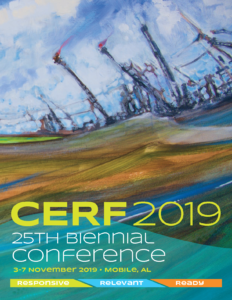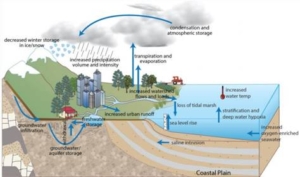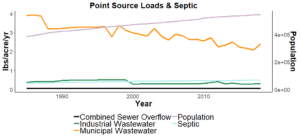CRC’s Environmental Management Career Development Program works with the Chesapeake Bay Program partnership to offer three-year staff opportunities for science, management, and policy graduates as the partnership works to protect and restore the Chesapeake Bay. While the CRC Staffers provide critical support to the Chesapeake Bay Program, their time is also spent exploring their own professional interests and preparing for the next steps in their careers.

Three of CRC’s Environmental Management Staffers presented at the Coastal and Estuarine Research Federation’s 25th Biennial Conference last week in Mobile, Alabama. CERF 2019’s theme was “Responsive | Relevant | Ready” which speaks to challenges facing nature and society and how research agendas are formed and directed at problem solving. We are thrilled to have contributions from our Staffers become a part of this critical dialogue and wish them well as they soak in all of the knowledge and opportunities that CERF 2019 has to offer.
Managing for climate change in the Chesapeake Bay watershed
Laurel Abowd, Environmental Management Staffer to the Chesapeake Bay Program’s Management Board, Principals’ Staff Committee, and Executive Council
Responsive | Relevant | Ready: New Directions in Coastal Science and Modeling
Poster Session – Wednesday, 4:30 PM-7:00 PM (G7)
The Chesapeake Bay Total Maximum Daily Load (TMDL) was established in 2010 and outlines limits on the amount of phosphorus, nitrogen and sediment that can enter the Chesapeake Bay and its tributaries to achieve water quality standards by 2025. The seven Chesapeake Bay watershed jurisdictions are each responsible for creating a Watershed Implementation Plan or WIP. WIPs serve as blueprints for jurisdiction water quality improvement plans and have powerful influence on practices adopted throughout the watershed. Jurisdictions have created Phase I and Phase II WIPs, which outlined practices in place through the 2017 midpoint assessment of progress and 2025 deadline. Jurisdictions are now developing their Phase III WIPs based upon the data and science from the 2017 midpoint assessment.
At their most basic level, WIPs are intended to improve water quality. However, since WIPs detail all the practices a jurisdiction intends to adopt, they offer rich opportunities for living resource co-benefits. In 2017, the Chesapeake Bay Program Principals’ Staff Committee (PSC) demonstrated leadership in connecting water quality improvements to climate change resiliency by agreeing to incorporate narrative guidance on how to address climate change in their Phase III WIPs. The PSC also committed to addressing the uncertainty of climate change science by setting targets dates on when to refine their estimated nitrogen and phosphorus loads based on improved climate projections. A critical component of incorporating climate change in to the Phase III WIPs is to better understand climate’s impact on the effectiveness of best management practices, which is an area the partnership has already began to investigate.

The various impacts of climate change on the Chesapeake Bay. Source: CBP, modified, University of MD IAN 2011
This poster will outline how the PSC expanded the scope of a water-quality centric regulatory document to incorporate climate considerations and will also include an initial look at how the jurisdictions follow suit.
Integrating monitoring and modeling data to better inform management decisions
Cuiyin Wu and Breck Sullivan, Environmental Management Staffers to the Chesapeake Bay Program’s Science, Technical Assessment, and Reporting Team
Innovative Approaches for Estuarine/Watershed Data Analysis, Mining, and Visualization
Monday, 10:45 AM (202B)
Poster Session – Monday, 4:30 PM-7:00 PM (B3)
Understanding local water quality is essential for managers and planners to implement targeted and cost-effective restoration and conservation programs and practices. The Chesapeake Bay watershed’s long-term water quality monitoring network provides a snapshot of trends in nitrogen, phosphorus and sediment in the region’s rivers and streams. Previous studies have identified regional drivers of water quality trends such as land use and nutrient inputs, but how these characteristics impact individual stations is of great interest to local managers and depends on the local watersheds.

Conestoga River nitrogen loads by source. The Estimated load from the agricultural sector is decreasing and wastewater has decreased significantly which coincides with the decrease in inputs from the wastewater sector.
We utilized the Chesapeake Bay Program’s Phase 6 Watershed Model to create a detailed inventory over multiple time periods of important watershed characteristics impacting water quality for 89 of the monitoring stations in the Chesapeake Bay Program’s non-tidal monitoring network. Characteristics were extracted for 1985, 1994, 2009 and 2017 by spatially matching monitoring station watersheds to modeling segments and include land use, nutrient inputs, and estimated breakdown of nitrogen and phosphorus sources by sector. Initial analysis of the 89 stations over the four time periods identified areas of rapid and intense land use change, areas with changing patterns in estimated annual loads of nitrogen and phosphorus, and changes in relative sources of nitrogen and phosphorus. This inventory provides information for local managers on drivers of water quality in these watersheds and creates a foundation for correlating changing local watershed characteristics with monitored water quality. Furthermore, a series of modeling scenario runs were performed to explore the effect of future land use and BMP implementation on the nutrient and sediment loads at each station. These results will increase understanding for local managers on the relationship between water quality and BMP implementation, resulting in better-informed water quality management decisions.
For additional information regarding CRC’s Environmental Management Career Development Program, please contact Melissa Fagan, Environmental Management Career Development Program Coordinator at faganm@chesapeake.org. Funding for CRC’s Environmental Management Career Development Program is provided through a cooperative agreement with the US EPA.
